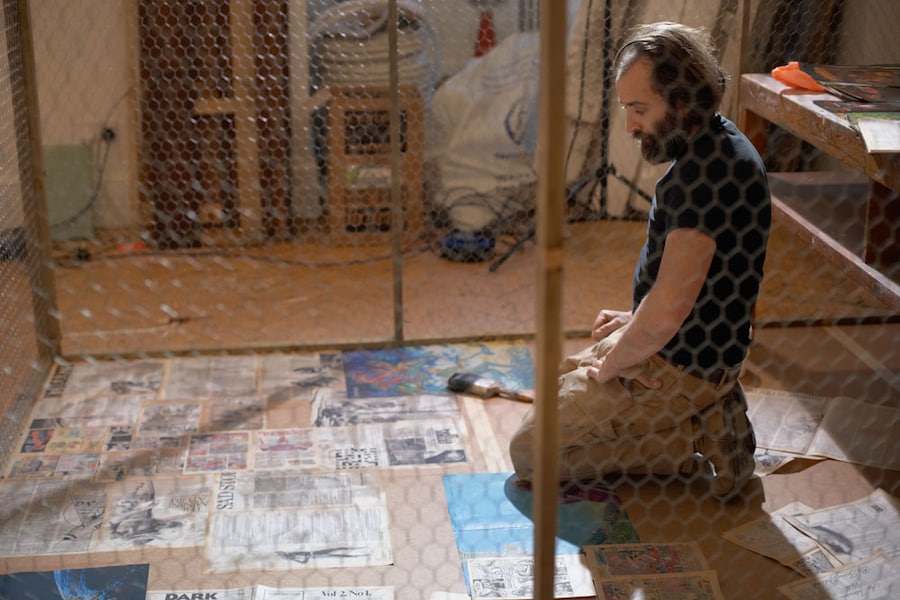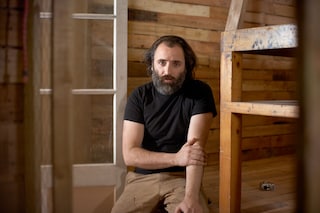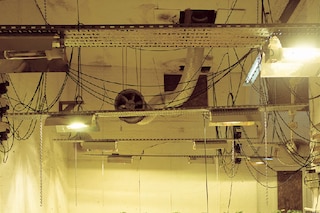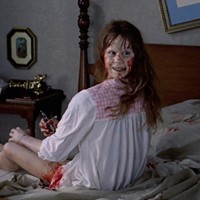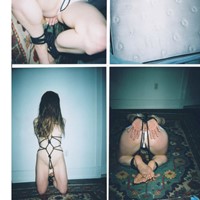Having twice fallen short of the Turner Prize, Mike Nelson is now getting the respect he deserves, as he represents the UK at the Venice biennale this summer
In Dante’s Divine Comedy the sign at the entrance of hell reads Abandon Hope All Ye Who Enter Here, and it’s something that comes to mind whenever you enter the disquieting and enigmatic art installations of British artist Mike Nelson. The labyrinthine mazes of entrapment, discovery, claustrophobia and enlightenment he creates have made him a cult artist with a serious following, and they are spaces where fiction and reality get very, very blurry.
After failing to nab the Turner Prize twice, Nelson is finally getting some proper attention from the art world, representing the UK at the Venice Biennale this coming June (the first ever installation artist commissioned by the British Council for Venice). This accolade hasn’t gone to Nelson’s head, though. In person, the bearded, hands-on artist is extremely modest and more than happy to talk about everything from carpentry and WWII mysteries to sci-fi novels. We found him among the pieces of wood and power tools he had amassed at Camden Arts Centre, where he was recreating a complex and lengthily-titled installation he made there a decade earlier during a residency for Simon Starling’s fascinating group show about time and history – Never The Same River (Possible Futures, Probable Pasts). “I feel like I’m the archivist, trying to recreate somebody else’s work,” explains Nelson. “But of course, it’s not somebody else – it’s just me at another time.”
The piece – A studio apparatus for Camden Arts Centre; an introductory structure: Introduction, a lexicon of phenomena and information association, futurobjectics, (in three sections), mysterious island*, or Temporary monument – is an ideal example of Nelson’s approach to art. It was originally made in 1998, when the London institution invited him to come and set up a temporary studio. The problem was, Nelson didn’t (and still doesn’t) have a studio. “I hate being watched while I’m working,” he explains, “even though I think an aspect of the performative is always inherent within the work.” To hide his process from prying eyes, Nelson built a fake corridor using rubbish that was lying around the gallery basement. “On the left is an old noticeboard with a piece of paper on it that looked like it had been left there for years, which is in fact an introduction to a book by Jules Verne called Mysterious Island,” he says. “If you were to look at the introduction wall walking in you might realise that in fact, this is a fake – a parody, in a sense, of a studio.” Beyond this fake entrance lies a staged space made of imagery and objects including dismembered teddy bears, a sheep’s skull, motorcycle helmets, strewn comic books and chicken wire.
For Nelson, the aim was to create something that would predict some kind of future for his work. He has made many different Mysterious Islands over the years, all using the Jules Verne text, with remarkably different results. Nelson’s pieces are often inherently ephemeral, so the idea of recreating a past installation is a strange concept. “It’s rather an awkward thing to do,” he says. “You’re rebuilding something which purported to predict the future, but you’re rebuilding it now and there’s some weird time lag thing going on – it’s not something I’ve completely got my head round.”
The work is classic Nelson – a strange sculptural space that the viewer has to manoeuvre around and interact with, creating narrative in a unique way. Literature is something that is at the heart of all Nelson’s work, and he draws on ideas from HP Lovecraft to Stanisław Lem, often comparing the structure of his spaces with the structure of a book. “I was at art college in the 80s when it was quite theoretical,” he recalls. “Lots of it went in one ear and out the other. It was a bit sludgy. Lots of the texts you would read made reference to popular culture or literary items that they would disassemble somehow and make sense of. When I left college I found myself reading literature again for the first time in years, especially writers who were probably of a lower echelon, or viewed as that in those days, such as Ballard or Lem – the science-fiction writers. The ideas I had read about in theories were there in these other books in a far more imaginative way.”
That notion of sharing ideas in a digestible and involving way spread to Nelson’s methods. “I found that people reacted far better accessing an area around the work, as opposed to what it’s actually about,” he explains. “It’s like guiding somebody into a certain thought process.” Nelson’s pieces invite the viewer to make their own connections and read the spaces in different ways, even if things click years later: “Art doesn’t get read at that certain point but if it’s any good, then you will read it through memory… You don’t know what might spark understanding. It’s totally fluid.”
Nelson began making site-specific work partly out of necessity. “When I left college I was just so skint,” he says.
“I had friends who had left college and took on studios, and they just used to spend their whole life working to pay for them.” Nelson used to make work in a barn in Yorkshire where his parents were living, thinking before he leapt: “I think there is a problem particularly inherent in students – they can find themselves making before they’ve actually thought. I couldn’t make until I got to the space. There was a period where I was forced to make the idea or develop it enough to be relative to the scale of the construction.” This period of reading, producing and “thinking” in the 1990s was one of the most intense in Nelson’s career. The result of that decade of focus was Nelson’s best-known work – The Coral Reef.
The installation of 15 interconnecting rooms was originally made for Matt’s Gallery in East London in 2000. This veritable rabbit warren included a deserted mini cab office, strange Americana, Islamic ephemera, a clown mask, drug gear, worn sofas and a Mario Brothers arcade game. Doors opened and closed with the creaks and bangs echoing around the corridors of the sculpture. The sense of disorientation aimed to reflect the cultural confusion of capitalism itself, with various belief systems brewing under its surface. Its underlying sense of aggression and disillusion felt very timely as the decade began to unfold. “The Coral Reef was also bound up with a frustration at people’s inability to look at sculptural objects,” says the artist. “This was a work that made you captive – you were caught inside of it and you had to look at it, but also the whole idea was that you were lost.”
Nelson remade The Coral Reef last year for the Tate Britain, and its winding maze of rooms hidden behind a nondescript door is still on show. “I haven’t been back into it. I can’t stand going into it,” he says. “It feels kind of archival to me now. I just mean it belongs in history somehow, in my history. I suppose there’s a kind of weighty responsibility of it as well as to where it resides now, which I find slightly difficult.” As a viewer, however, the results are just as addictive and mesmeric as the original – a slip through time into an alternate reality.
As a response to his infamous installation, Nelson constructed A Psychic Vacuum in an abandoned building in NYC’s Lower East Side back in 2007. Drawing on Stanisław Lem’s A Perfect Vacuum, the installation explored the obviously monumental void of the Twin Towers. The building was filled with voodoo altars, remnants of Christianity, icons of patriotic Americanism and Moorish gates. There were small rooms that seemed to exude the aftermath of violence with blood spattered here and there and a bricked wall hung with baseball bats… one huge floor was filled with sand, highlighting the fragility of the city.
“The idea of The Coral Reef was that a coral reef was a fragile and complicated substructure, where different belief structures tried to get a foothold under the surface of the prevalent ideology and economic structure of capitalism,” says Neslon. “The idea was to flip that and bury an idea of more esoteric belief structures but under a metaphorical sea of sand.”
Some imagery remerges throughout Nelson’s spaces – from motorcycle gangs to chicken coops and images from the Middle East. “This thing about Islam and the Middle East has been of constant interest to me,” he says. “What I find interesting is that its culture is incredibly intoxicating. There is a draw to it that I can somehow understand – that idea of belief.”
That interest in intoxication emerged most obviously in the cannabis farm space he built in Margate in 2005 Between A Formula And A Code, consisting of a warren of empty, worn out internet cafes, hydroponic cannabis plants (which were not narcotic) and deep red photographic development rooms. Abandoned, dilapidated spaces are more than an aesthetic choice for the artist. “I suppose when I first started, these were the spaces I was familiar with. But also there’s always that sense of trespass. There’s a patina isn’t there? There’s time. There’s more sense of inhabitation, of life, of humanity in a more derelict, more worn interior than there is in a new.”
There are a number of artists that make work comparative to Nelson’s – the late Edward Kienholz, Gregor Schneider, the interactive theatre company Punchdrunk – but installation pioneer Paul Thek is the artist that Nelson names as the closest to his heart. He discovered the artist in Rotterdam in 1996, stumbling across a piece of work in a catalogue. “Sometimes you look at people’s work from the past and they’ve done something similar to you and it’s very disappointing. Whereas sometimes you see some people’s work and it actually just makes you feel, ‘My God! I’m not alone.’ It’s very exciting! Paul Thek said that you wouldn’t be adult if you believed that your work was original. I think, ultimately, the idea of being a cipher through which a certain kind of work comes
is interesting.”
Cipher or not, Nelson seems to be both pushing forward and reworking the past at the same time. He showed a work in Venice once before – a decade ago (though not as the headliner in the British Pavilion). “Exhibiting there is another ten-year piece of nostalgia for me,” he points out. “The Giardini (where the British Pavilion is located in Venice) is a kind of difficult home… It’s like a theme park, isn’t it? I haven’t really quite got the grasp of how to deal with it. But it’s good to do. I was quite surprised. I’ve never been very lucky with juries!”
Never The Same River (Possible Futures, Probable Pasts) is at Camden Arts Centre until Feb 20; The Coral Reef is on show at Tate Britain; The British Pavilion at Venice Biennale runs June 4–Nov 27
Photography by Linda Brownlee
